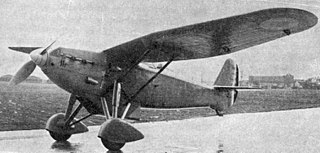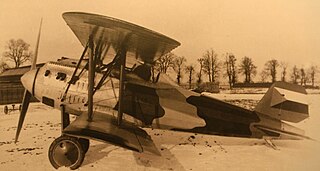
The ANF Les Mureaux 110 and its derivatives were a family of French reconnaissance aircraft developed in the 1930s. They were all-metal, parasol-wing monoplanes that seated the pilot and observer in tandem open cockpits. The aircraft were widely used in the Battle of France, but were all scrapped soon thereafter.

The FBA Type H was a French reconnaissance flying boat produced in large numbers in France and Italy during World War I by Franco-British Aviation.

The Morane-Saulnier M.S.325 was a French Air Force fighter aircraft built by Morane-Saulnier in 1933 to meet the requirements of 1930 fighter aircraft specification. The design was unsuccessful and was abandoned in 1934.

The Nieuport-Delage NiD 120 series was a series of French single-seat parasol monoplane fighter aircraft of the 1930s. It was built in a number of versions, fitted with various types of engines, with six aircraft designated NiD 123 being sold to Peru.

The ANF Les Mureaux 170 was a prototype French fighter aircraft of the 1930s. It was a single-engined, single-seat parasol monoplane, but only two were built, the type being rejected for service by the French Air Force.

The Nieuport-Delage NiD 43 was a single engine, two seat biplane fighter aircraft designed and built for shipboard use in France in 1924.

The Loire-Nieuport 161 was a single-seat, single-engine, all-metal, low-wing monoplane fighter designed and built in France in 1935 to compete for a government contract. Accidents delayed its development and only three prototypes were completed.
The Wibault Wib 1, Wib C1 or, later, Wib 1 C1 was a French World War I single seat, single engine fighter aircraft prototype. Flown near the end of the war, it was not selected for production.

The SNCAC NC-600 was a prototype French twin-engined long-range fighter aircraft, developed by SNCAC from the earlier Hanriot H.220 fighter. The type never entered service, with development being ended by the French surrender in June 1940.

The Wibault 13C.1 Trombe (Whirlwind), later known as the Wib 130C.1 Trombe was a single seat, parasol wing lightweight fighter aircraft designed and built in France in the 1920s. It was developed into the more powerful Wib 170C.1 Tornade (Tornado) but government interest in lightweight fighters soon waned.

The Letov Š-7 was a single-seat, single-engine biplane fighter aircraft designed and built in Czechoslovakia in the early 1920s. It was designed for a single-seat fighter competition but did not reach production.
The Letov Š-22 was a single-seat, single-engine aircraft designed and built in Czechoslovakia in the mid-1920s. A parasol-wing Dewoitine-style fighter, it was not successful, and only one was built.
The Dewoitine D.25 was a single-engine, two-seat, parasol-wing fighter aircraft built in France in the 1920s. The 1925 French two-seat fighter programme was cancelled before any orders were placed, but four examples were exported to Argentina.
The Hanriot HD.5 was a French two-seat fighter aircraft prototype, built towards the end of World War I. A single-engine biplane with an unusually narrow gap between the upper and lower wings, it did not enter production.

The Hanriot HD.15 was a French two seat fighter aircraft fitted with a supercharger for good high altitude performance, built in the 1920s. Three were ordered by Japan but lost at sea during delivery.
The Hanriot HD.20 was a French single seat shipboard fighter aircraft prototype completed in 1923. Only one was built.

The Hanriot H.26 was a French single seat fighter aircraft prototype completed in 1923. Only one was built.
The Potez 230 was a French lightweight single-seat, single-engined fighter aircraft. One prototype was built and flew in 1940, but no production followed, with the prototype being captured and shipped to Germany for study.

The ANF Les Mureaux 180 was a prototype French fighter aircraft of the 1930s. designed and built by Les Ateliers de Construction du Nord de la France et des Mureaux. It was a single-engined, two-seat, gull wing monoplane, only one was built and the programme was abandoned as obsolete.
The FBA Avion Canon was a two-seat cannon-armed biplane fighter, designed and built in France from 1916. due to unsatisfactory performance, development of the Avion Canon was abandoned.
















